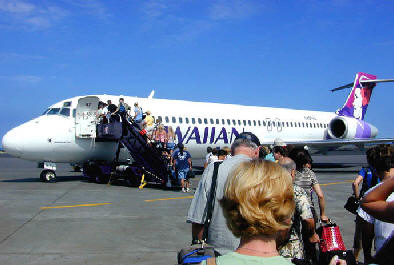
NEWSROOM
 |
NEWSROOM |
|
|
|
|
|||
|
By Mike Mitchell |
||||
 |
January 20, 2010 - Hawaiian has reached agreements
with its pilots’ union, the Air Line Pilots Association (ALPA), flight
attendants’ union, the Association of Flight Attendants (AFA-CWA),
dispatchers’ union, the Transport Workers Union (TWU) and the
International Association of Machinists and Aerospace Workers Clerical
Division (IAM-C). Hawaiian is continuing to work with its IAM –
Mechanics Division on a new agreement, its last remaining work group in
contract negotiations. Hawaiian Airlines and the International Association of Machinists and Aerospace Workers Clerical Division (IAM-C) announced yesterday that the union’s membership has ratified the negotiated agreement on a new four-year contract by a 75 percent vote. The new contract provides IAM-C’s membership Hawaiian’s largest single work group with increased compensation, while also allowing for operational improvements that benefit the company. |
|||
|
IAM-C represents 1,245 employees
at Hawaiian in a wide range of positions, encompassing airport
customer service, ramp, reservations, schedule planning, purchasing,
records, and crew scheduling. Mark Dunkerley, Hawaiian’s president
and CEO, said, “Like the other labor agreements we have reached,
this contract will improve the standard of living for our employees
while helping to improve operating efficiency for the company.” Randy
Kauhane, IAM assistant general manager, District Lodge 141,
commented, “In these uncertain economic times, we are pleased our
members have a new contract in place that will keep them secure for
the next four years. We appreciate all the efforts made by our
negotiating committee and Hawaiian in reaching this agreement that
benefits all parties involved.”
Hawaiian pilots endorse new contract; agreement
improves pay, retirement and scheduling flexibility. Int’l (ALPA) have
ratified a tentative contract agreement, the latest sign that the
airline industry and the piloting profession are recovering from the
bankruptcy doldrums of the past decade. Ninety percent of the HAL pilots
eligible to vote cast ballots, with 83 percent of the group voting in
favor of the agreement – a more than four-to-one margin. “This contract is a win-win for our members as well as
the airline,” said Capt. Eric Sampson, chairman of ALPA’s HAL Master
Executive Council. “It rewards our pilots for their repeated sacrifices
over the years on behalf of Hawaiian, and positions our company for
future success well into this new decade. We’re looking forward to
working with management to upgrade our fleet and expand our aloha spirit
across the Pacific, and we would like to thank the people of |
||||
|
The 68-month
agreement will give pilots pay increases of between four and six percent
immediately, and total increases of between 15 and 22 percent over the
term of the contract. The agreement also increases the company
contribution to the pilots’ retirement plans, provides HAL management
more flexibility in pilot training and scheduling, and allows Hawaiian
to acquire or code share with a turboprop feeder airline, provided the
feeder carrier does not compete with HAL’s existing inter-island
turbojet operation.
“The substantial
gains in this contract confirm the favorable patterns for pay, benefits
and work rules that are long overdue for pilots,” said ALPA President
Capt. John Prater. “The Hawaiian agreement is a success story that
proves a strong and unified pilot group working together can take charge
of their destiny and move both themselves and their airline forward.
ALPA sincerely appreciates the valuable assistance provided by the
National Mediation Board in reaching a settlement.”
Hawaiian is the
nation’s highest-ranked carrier for service quality and performance in
2008 in the 19th annual Airline Quality Rating study. Hawaiian has also
led all
Now in its 81st
year of continuous service for
Inter-Island
Airways, the forerunner of the airline which is now known as Hawaiian
Airlines, was incorporated on January 30, 1929. Inter-Island Airways, a
subsidiary of Inter-Island Steam Navigation Company, began operations on
October 6, 1929 with a Bellanca CH-300 Pacemaker, providing short
sightseeing flights over O’ahu. Scheduled service began a month later on
November 11 using Sikorsky S-38s with a flight from
On October 1,
1941, the name was changed to Hawaiian Airlines when the company phased
out the older Sikorsky S-38 and Sikorsky S-43 flying boats. In 1966 jet
travel started with the acquisition of Douglas DC-9 aircraft, which cut
travel times in half on most of the routes. In 1984 the company began to
operate charter services to the South Pacific using Douglas DC-8
aircraft, and soon added Lockheed L-1011 aircraft to the fleet for West
Coast services. As the west coast market grew, the South Pacific market
shrunk, and service was reduced when the company's DC-8s were retired in
1993; and when the L-1011s were replaced by the McDonnell Douglas DC-10
in 1994.
Hawaiian Airlines
filed for Chapter 11 bankruptcy protection on March 21, 2003 with
operations still continuing, and at the time was overdue for $4.5
million USD worth of payments to the pilots' pension plan. Within the
company, it was suggested that the plan be terminated. As of May 2005,
Hawaiian Airlines had received court approval of its reorganization
plan. The company emerged from bankruptcy protection on June 2, 2005,
with reduced operating costs through renegotiated contracts with its
union work groups; restructured aircraft leases; and investment from RC
Aviation, a unit of San Diego-based Ranch Capital, which bought a
majority share in parent company Hawaiian Holdings Inc in 2004.
Hawaiian has never
had a fatal accident in its entire history and is the oldest |
| ©AvStop Online Magazine Contact Us Return To News |
|